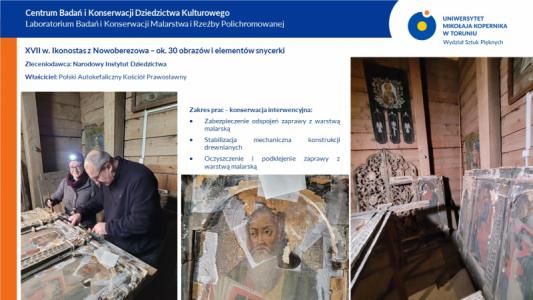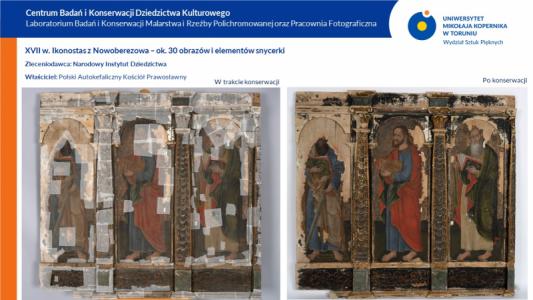Laboratory for Research and Conservation of Paintings and Polychrome Sculptures
Leader: dr hab. Jacek Stachera, prof. UMK
The scope of activities of the Laboratory is focused on statutory research and projects, as well as commercial research services in the following areas:
- Conservation and restoration of historic objects – including polychrome sculpture and paintings on various substrates (wood, canvas and other textiles, walls), research and conservation of transferred paintings, as well as artistic craftsmanship objects (e.g., frames, functional woodwork), with a focus on:
- Identifying execution techniques,
- Identifying stratigraphy of historical alterations present in the object,
- Assessing the state of preservation, including non-invasive assessment,
- Determining material properties,
- Identifying causes of object deterioration,
- Developing a detailed conservation program,
- Researching methods of transfer of wall paintings,
- Performing treatments such as cleaning, straightening, reinforcing textile painting supports, varnishing, impregnation, and lining of easel paintings,
- Selecting modern methods and agents for surface dirt removal from paintings,
- Conducting comprehensive conservation and restoration of historic objects, along with the preparation of conservation documentation.
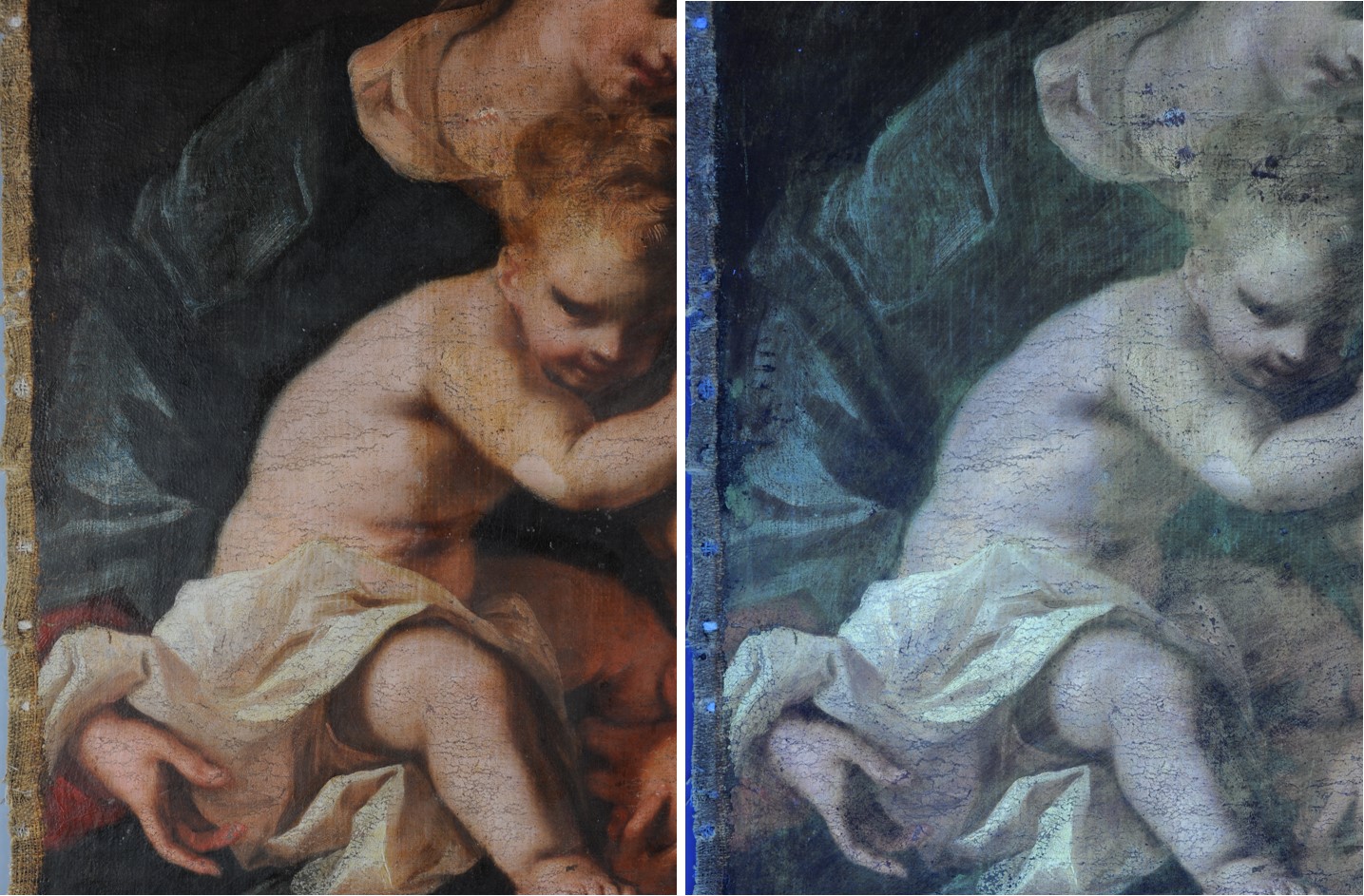
Our Lady with Child and St. Anthony, National Museum in Przemyśl. Oil painting on canvas during removal of varnish, photograph in visible light and fluorescence induced by ultraviolet radiation (photo: E. Szmit-Naud)
The film: Conservation treatment of an Orthodox Ikonostas from the church in Nowoberezowo:
Specialized Equipment for Conservation Treatments:
- Varnishing chamber (room) with a high-efficiency exhaust system,
- Backlit tables,
- High- and low-pressure large-format lining tables,
- Stereoscopic microscopes with image recording capability,
- Mechanical cleaning device using granulated abrasive materials,
- Specialized laser for cleaning historic objects.
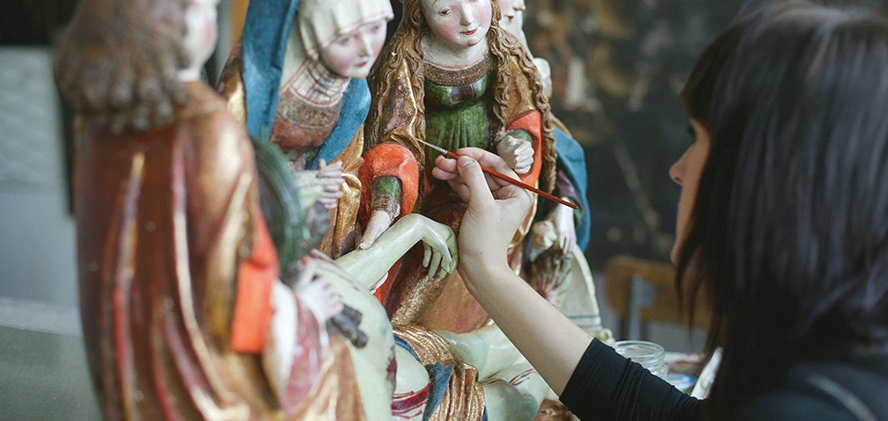
Polychrome restoration on a medieval wooden sculpture (photo: Adam Adamski)
-
Examination of Easel Paintings and Polychrome Sculptures
Analysis of the composition of original materials (pigment identification) and past alterations (overpainting, secondary varnishes). Determining the authenticity of individual layers, provenance, creation period, and overall authenticity of the object.
Analytical Techniques Used:
- Stratigraphic analysis of artwork structure using UV-VIS microscopy (Nikon E600 microscope with a fluorescence attachment).

Cross-Section of a Sample Taken from a 16th-Century Polychrome Altarpiece: photograph in visible light and UV-induced fluorescence photography. Based on these images, stratigraphic tables are created to document the arrangement of all layers. Preliminary identification of certain pigments is also possible—in this case, azurite in the original layer and zinc white in the secondary layer (photo: M. Iwanicka)
- Scanning XRF Spectroscopy (macro XRF, MA-XRF) – Elemental mapping across the entire surface of a painting, enabling approximate pigment identification (M6 device, Bruker – in collaboration with Centre for Modern Interdisciplinary Technologies and the Institute of Physics, Nicolaus Copernicus University).
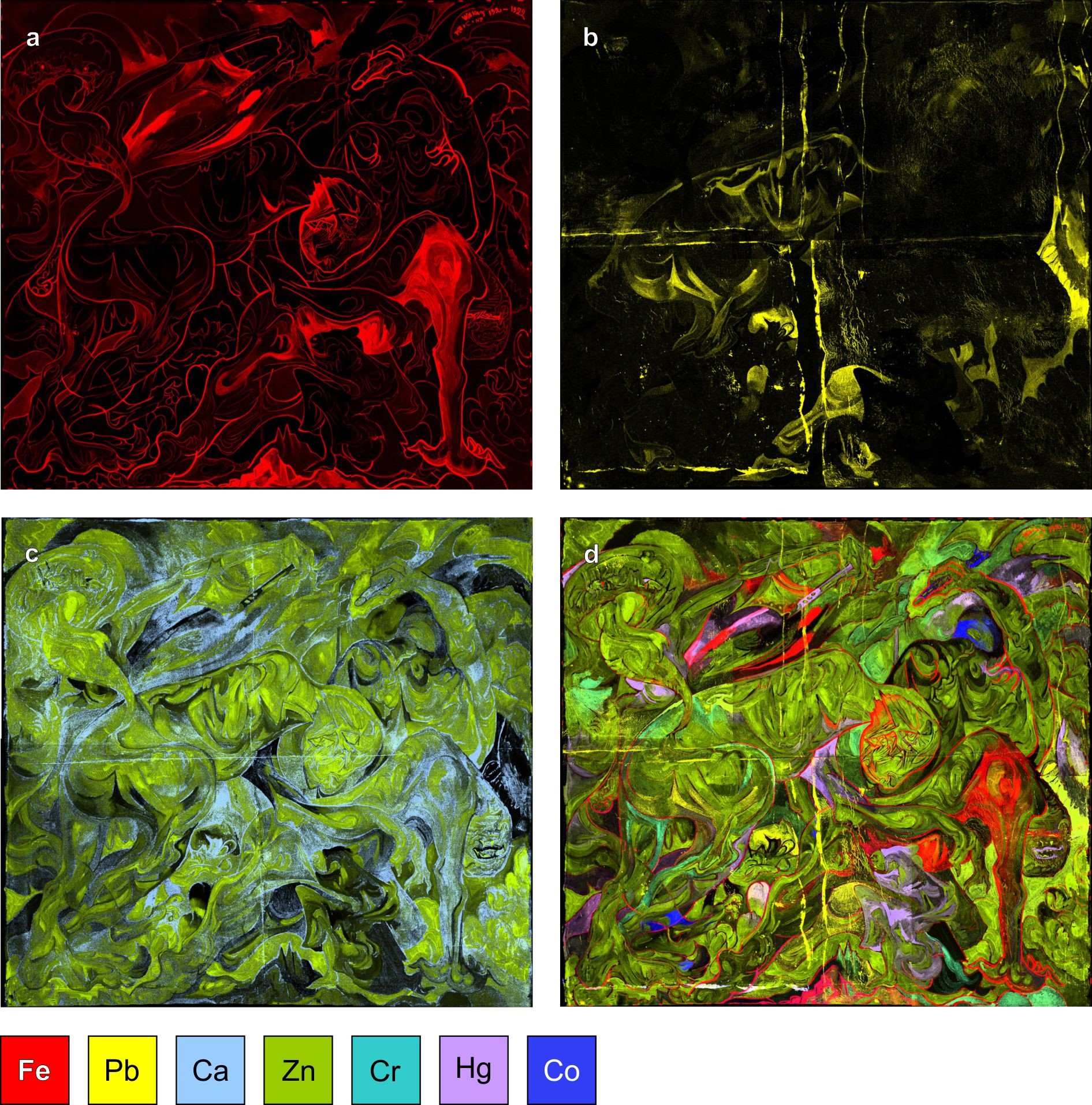
Stanisław Ignacy Witkiewicz, Struggle. Chopping the Forest; Museum of Art in Łódź. Macro XRF imaging – elemental distribution maps: (a) iron (Fe-Kα line); (b) lead (Pb-Lβ line); (c) combined maps of zinc (Zn-Kα line) and calcium (Ca-Kα line); (d) combined maps of zinc (Zn-Kα line), iron (Fe-Kα line), lead (Pb-Lβ line), chromium (Cr-Kα line), cobalt (Co-Kα line), and mercury (Hg-Lα line). The results were obtained in the Polish Distributed Research Infrastructure for Heritage Science ERIHS PL project within the MOLAB/FIXLAB.PL framework (data analysis: M. Iwanicka).
- Scanning Infrared Reflectography – Based on an InGaAs camera, 950-1700 nm (since 2022); Apollo device, Opus Instruments.
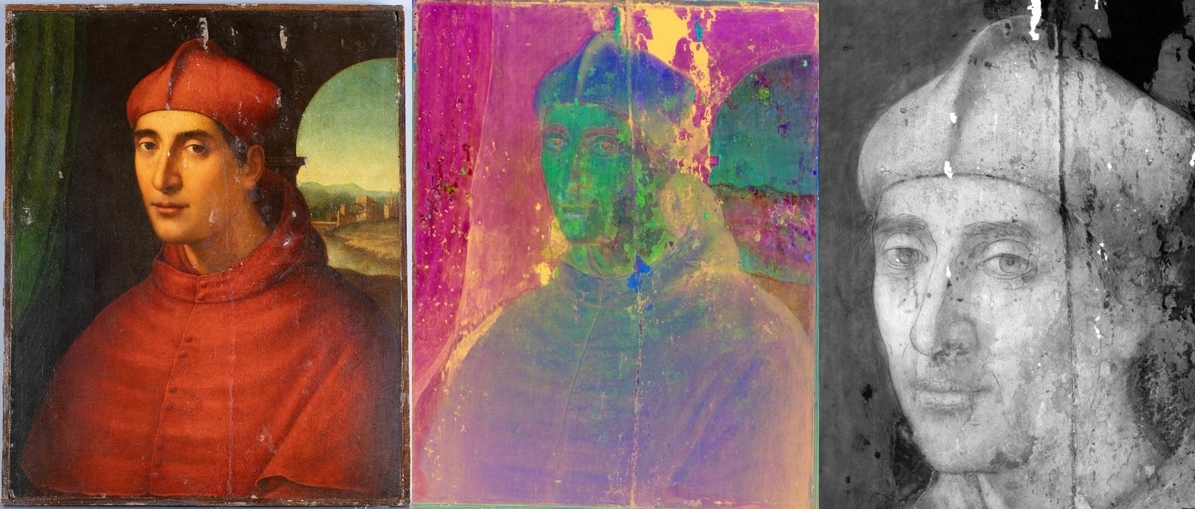
Example of Infrared Reflectography Imaging – Apollo System (Opus Instruments, UK). Portrait of Cardinal Farnese (?) from the collection of Wawel Royal Castle, tempera/oil on panel, 16th/17th century. From left: photograph in visible light, PCA imaging based on infrared reflectography (900-1700 nm), infrared reflectography imaging of the underdrawing (1250-1510 nm). (Data analysis: M. Iwanicka)
- Optical Coherence Tomography (OCT) – non-invasive analysis of the near-surface structure of a work of art (in collaboration with Centre for Modern Interdisciplinary Technologies and the Institute of Physics, Nicolaus Copernicus University).
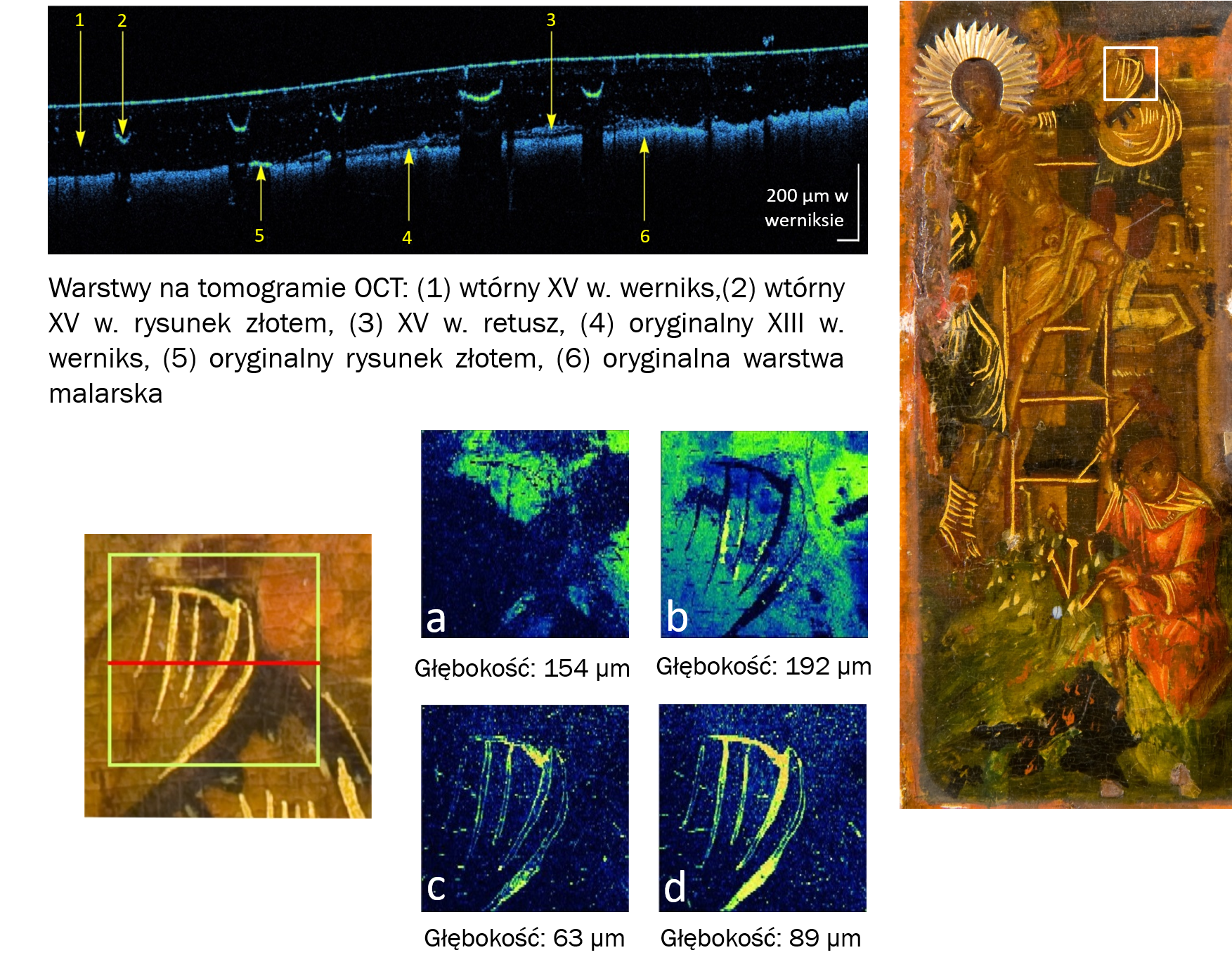
Scanning Result of a 13th-Century Byzantine Staurotheke (Polychrome Reliquary) (data analysis: Magdalena Iwanicka)
- Reflectance Spectrophotometry – colorimetric measurements considering gloss, assessment of color changes on the surface of artworks and conservation materials

Spherical Reflectance Spectrophotometer (XRite, USA). Photo: E. Szmit-Naud
- Glossometry – multi-angle gloss meter.
 Instrumental Assessment of Paint Layer Gloss – multi-angle gloss meter ZGM1110 (Zehnter, Switzerland). Photo and data analysis: E. Szmit-Naud.
Instrumental Assessment of Paint Layer Gloss – multi-angle gloss meter ZGM1110 (Zehnter, Switzerland). Photo and data analysis: E. Szmit-Naud.
- Research on Biodeterioration of Canvas and Wood – assessment of fungal and bacterial activity, identification of microorganisms – conducted by the Laboratory for Heritage Biodeterioration Studies.
- Research on Conservation Materials – including strength testing of materials and structures used in conservation and restoration, aiming to enhance the quality and durability of conservation, restoration, and reconstruction treatments for paintings on various substrates, polychrome wooden sculptures, and craftsmanship objects:
- Strength testing – conducted using a Zwick Z005 TN ProLine testing machine, equipped for peel and delamination tests as well as hardness testing.
- Lightfastness testing – performed with the Xenotest Alpha device. It allows control and regulation of irradiation conditions, relative humidity, and temperature on the sample and within the chamber. The testing conditions comply with standards for lightfastness of textiles, plastics, coatings, and paints (PN-EN ISO, ASTM, AATCC TM, including PN-EN 4892-1:2001, 4892-2:2013-06E, ISO 105-B02, B04, B06).
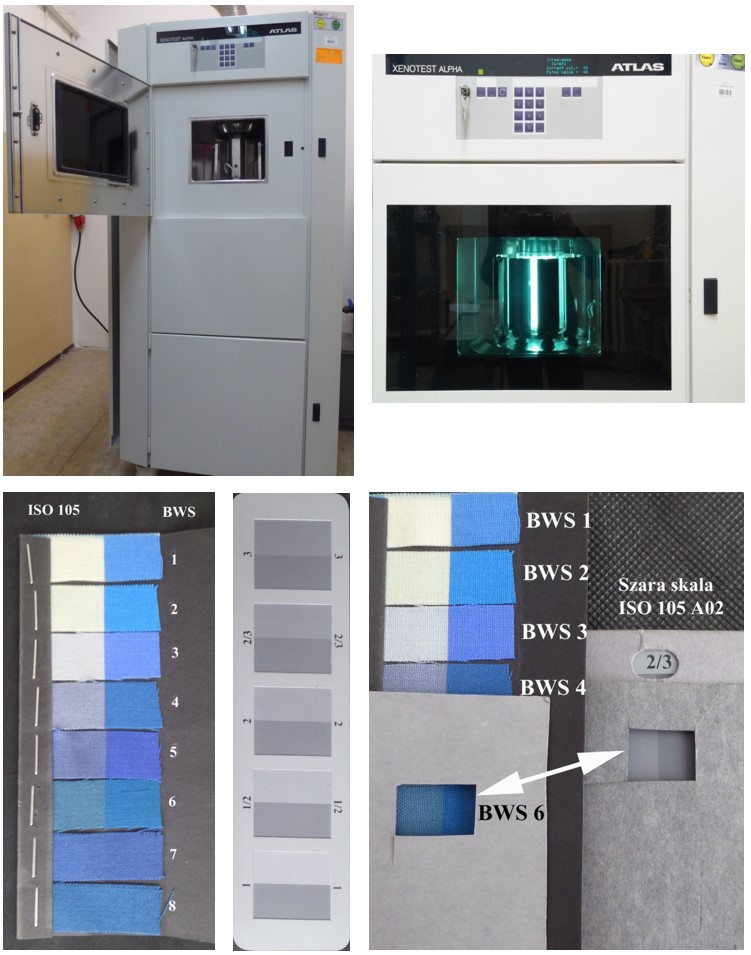
Xenotest Alpha High Energy Device (ATLAS, USA) – Monitoring of aging cycle progression and changes based on ISO 105 (Blue Wool Standard, BWS) and ISO 105 A02 (Gray Scale for Color Change Assessment). Photo and data analysis: E. Szmit-Naud.
- Research on Conservation Materials and Physical Conditions in the Vicinity of Historic Objects – utilizing an aging climate chamber with a temperature and humidity (temp. range from +10°C to +95°C) as well as temperature without added humidity (temp. range from -42°C to +190°C).
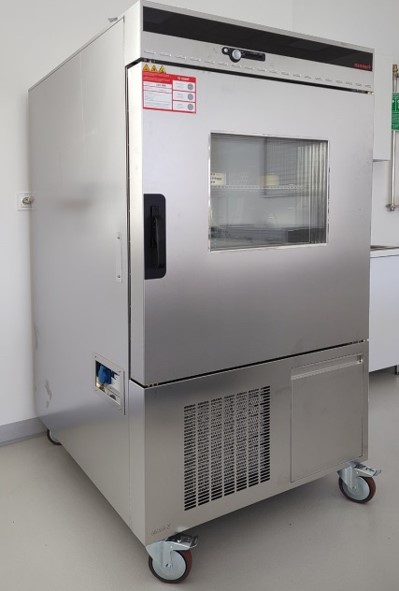
Aging climate chamber Memmert CTC 256
- Research on New Conservation and Decorative Materials – assessing durability and optical properties (e.g., pigments, painting binders, consolidants).
Selected Projects Completed by Our Laboratory:














